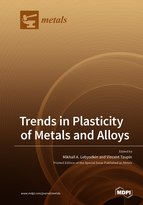Trends in Plasticity of Metals and Alloys
A special issue of Metals (ISSN 2075-4701).
Deadline for manuscript submissions: closed (30 November 2020) | Viewed by 28565
Special Issue Editors
Interests: self-organization phenomena in plasticity; plastic instabilities; metal alloys; relationships between mechanical and physical (magnetic, electronic) properties
Special Issues, Collections and Topics in MDPI journals
Interests: multiscale modeling of plasticity and interfaces in crystals; dislocations; disclinations; grain boundaries; size effects; strain hardening
Special Issue Information
Dear Colleagues,
The last few decades have seen a considerable progress in the development of high performance metals and alloys that have microstructures and plastic behaviors with a high level of complexity. Ultrafine-grain materials, high-entropy alloys, and metallic glasses have been the focus of research and are gaining a place in the industry. Concurrently, the collective, heterogeneous, and self-organized nature of plastic deformation, manifesting itself on mesoscopic scales, has been generally recognized. Such progress demanded the development of advanced multiscale modeling frameworks (Ab-Initio, molecular dynamics, discrete dislocation dynamics, strain gradient models, etc.), experimental characterization tools (in-situ TEM, DIC, nanoindentation, micropillar testing, etc.) and analyses of the observed and simulated complex spatiotemporal behaviors, which aim at establishing process–microstructure–property links and bridging gaps from the elementary atomic-scale mechanism, up to the laboratory sample dimension. Progress in the field of plasticity of metals and alloys keeps growing fast and new materials are constantly being developed, concurrently with the emergence of modern processing routes. In parallel, considerable advances are made in the characterization and modeling of microstructures, with an emphasis on setting up a synergy between theoretical and experimental methods. This Special Issue aims at synthetizing recent progress and trends in the area of plasticity of metals and alloys, with a focus on:
- New approaches to old questions and traditional model materials, to get a deeper understanding of physical mechanisms;
- New materials and processing routes (high entropy alloys, metallic glasses, severe plastic deformation, additive manufacturing, etc.);
- Multiscale modeling (atomistic models, discrete dislocation dynamics, strain gradient models, homogenization models, etc.);
- Experimental characterization methods (HR-DIC, 3D-EBSD, HR-TEM, ECCI, TKD, etc.).
Dr. Mikhaïl A. Lebyodkin
Dr. Vincent Taupin
Guest Editors
Manuscript Submission Information
Manuscripts should be submitted online at www.mdpi.com by registering and logging in to this website. Once you are registered, click here to go to the submission form. Manuscripts can be submitted until the deadline. All submissions that pass pre-check are peer-reviewed. Accepted papers will be published continuously in the journal (as soon as accepted) and will be listed together on the special issue website. Research articles, review articles as well as short communications are invited. For planned papers, a title and short abstract (about 100 words) can be sent to the Editorial Office for announcement on this website.
Submitted manuscripts should not have been published previously, nor be under consideration for publication elsewhere (except conference proceedings papers). All manuscripts are thoroughly refereed through a single-blind peer-review process. A guide for authors and other relevant information for submission of manuscripts is available on the Instructions for Authors page. Metals is an international peer-reviewed open access monthly journal published by MDPI.
Please visit the Instructions for Authors page before submitting a manuscript. The Article Processing Charge (APC) for publication in this open access journal is 2600 CHF (Swiss Francs). Submitted papers should be well formatted and use good English. Authors may use MDPI's English editing service prior to publication or during author revisions.
Keywords
- Metals
- Alloys
- Mechanisms of plasticity
- Microstructure design
- Novel metallic materials
- Novel processes
- Advanced characterization methods
- Multi-scale experiment and modeling
- Collective behavior of defects






